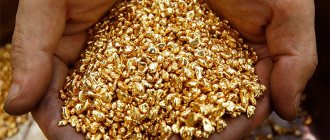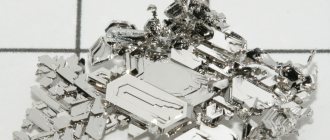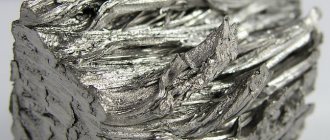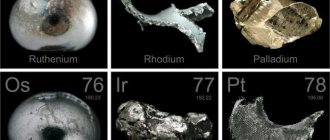A noble metal of a whitish silver color, which is part of the platinum group, is rhodium. What kind of metal it is and where it is used is of interest to many. The scope of application is quite diverse; this chemical element is found in jewelry, the automotive industry (used in catalytic converters to purify harmful exhaust gases), glass production, and the electrical industry. It is highly resistant to corrosion and mechanical damage.
What kind of metal is rhodium?
Rhodium (Rh) is considered a unique precious metal due to its properties. But few people know what it is. Mendeleev's periodic table of chemical elements has the platinum group (platinum, palladium, osmium, ruthenium, iridium), which also includes rhodium.
It belongs to the rarest precious metals. Known thanks to the works of the English scientist Wollaston, who discovered a bright pink powder in a platinum solution. After rolling in a hydrogen atmosphere, a white-silver metal emerged from the powder.
Properties of rose metal
Platinoid, silver in color with a slight bluish tint, is the metal rhodium. This is a chemical element with atomic number 45 in the periodic table. The stable isotope of rhodium is known - 103Rh.
Metal density 12.41 g/cm3.
The chemical properties of rhodium are close to the basic properties of platinoids. Metal doesn't like to react with other elements. It begins to dissolve in aqua regia when boiled, reacts with concentrated sulfuric acid when heated, and completely ignores nitric acid.
We recommend: BERILLIUM - the metal of the present and future
In chemical reactions it exhibits oxidation states +5, +4, +3, +2, +1.
The crystal structure of the lattice is face-centric, cubic.
| Properties of the atom | |
| Name, symbol, number | Rhodium (Rh), 45 |
| Atomic mass (molar mass) | 102.90550(2)[1] a. e.m. (g/mol) |
| Electronic configuration | [Kr] 4d8 5s1 |
| Atomic radius | 134 pm |
| Chemical properties | |
| Covalent radius | 125 pm |
| Ion radius | (+3e)68 pm |
| Electronegativity | 2.28 (Pauling scale) |
| Electrode potential | +0.8v |
| Oxidation states | 5, 4, 3, 2, 1, 0 |
| Ionization energy (first electron) | 719.5 (7.46) kJ/mol (eV) |
| Thermodynamic properties of a simple substance | |
| Density (at normal conditions) | 12.41 g/cm³ |
| Melting temperature | 1963°C |
| Boiling temperature | 3727°C |
| Ud. heat of fusion | 21.8 kJ/mol |
| Ud. heat of vaporization | 494 kJ/mol |
| Molar heat capacity | 24.95[2] J/(K mol) |
| Molar volume | 8.3 cm³/mol |
| Crystal lattice of a simple substance | |
| Lattice structure | cubic face-centered |
| Lattice parameters | a=3.803 Å |
| Debye temperature | 480K |
| Other characteristics | |
| Thermal conductivity | (300 K) 150 W/(m K) |
| CAS number | 7440-16-6 |
If you want to melt rhodium, find a device that will give a temperature of 1963°C. The metal begins to boil at 3727°C.
History of rhodium
The place where such a unique metal was discovered is the Urals. It was here that, at the beginning of the 19th century, deposits of native platinum were discovered, which after several years reached two tons. Platinum was sent to St. Petersburg for processing, and noble rhodium (since nothing was known about it yet) acted as waste.
The metals accompanying platinum (rhodium, palladium, iridium, osmium), located in the deposits of the Ural Mountains, were discovered only in the forties of the 19th century by Professor Klaus Karl Karlovich. During the same period, he also discovered ruthenium, an unknown precious metal in those years, which is currently part of the platinum group.
Interesting! Until the beginning of the 20th century, Russia produced approximately 95 percent of the world's Pt reserves. But rare precious metals of this group were not used, so rhodium and others were sold abroad for practically nothing. The properties of this rare metal have remained incompletely studied to this day.
At the beginning of the 20th century, the Institute was opened, where they studied not only platinum, but also other precious metals. Rhodium was very carefully studied at that time and was first obtained in the Soviet Union in 1925.
Today, Rh, as well as other platinoids, metals belonging to the platinum group, are extracted from “raw” platinum or by purifying gold from impurities (during refining).
Look for Rhodium in Platinum
Rhodium, unlike many metals, does not have deposits with industrial mineralization. The rare metal is extracted from platinum ores, gold-bearing placer deposits, and native platinum. In copper-nickel ores, the content of rare platinum is negligible - a few milligrams per ton of ore.
Informative: there is a mineral where the share of rhodium is 11.3%. This is native Nevyanskite. A reason for pride - it was discovered by attentive, inquisitive mining workers of the Urals, not far from the city of Nevyansk.
Why is rhodium valuable?
Rhodium is popular due to its special properties. These include:
- significant metal melting temperature (more than 1960 degrees);
- resistance to the influence of external factors.
The possession of such characteristics has made the use of rhodium quite widespread. It is used in many industries.
Glass
It is a major consumer of this metal. An alloy of rhodium and platinum is used to produce containers intended for melting glass mass. And also noble rhodium is used to produce the finest threads - quartz and glass. The surface of this precious metal is highly reflective. Compared to argentum, it is lower, but rhodium’s resistance to corrosion is higher and it can withstand higher temperatures. Even when exposed to a voltaic arc atmosphere, rhodium-plated surfaces do not tarnish, which makes it possible to cover floodlight reflectors and mirrors for various technical purposes with this metal. One of the areas of application of metal Rh is the manufacture of mirrors for laser systems of enormous power.
Jewelry
Rhodium, like platinum and palladium, has found its application in jewelry. Due to its high melting point, color and shine, as well as sufficient hardness, rhodium is valuable. As you know, the strength index is 6, while gold and silver have only 2.5. But despite all the advantages, this noble metal is quite fragile, which makes it impossible to use it as a base metal in the manufacture of jewelry. Rhodium in jewelry acts only as a protective and decorative coating.
Chemical
In it, the metal is used together with platinum in the production of heat-resistant chemical glassware, which has increased strength, various instruments, and other things. Rhodium detectors are used in nuclear reactors to measure neutron fluxes.
Electrotechnical
In it, rhodium plating is applied to connectors and contacts; the metal is also used to make filters for LCD monitors and temperature sensors.
Rhodium reserves in the world are not that large and consist of several tens of tons. The cost of rhodium is several times higher than the price of gold, but this not only does not reduce the demand for it, but every year it increases more and more.
Receipt
Rhodium is extracted from native platinum.
Raw native platinum is placed in porcelain cauldrons, after which it is treated with aqua regia while heating for 24 hours. Rhodium, almost all platinum, palladium, base metals (iron, copper and others), partially ruthenium and iridium go into solution, and osmide iridium, quartz, chromium iron ore and other impurities remain in the sediment. Subsequent addition of ammonium chloride to the solution produces ammonium hexachloroplatinate(IV) (NH4)2PtCl6. The remaining solution is evaporated, up to 6% rhodium remains in the sediment; palladium, ruthenium, iridium, platinum are also present (all of it cannot be separated using NH4Cl) and base metals. This precipitate is dissolved in water and the platinum is separated again in the same way. The solution, in which rhodium, ruthenium and palladium remain, is sent for purification and separation. Rhodium is extracted in different ways. There is a known method proposed by the Soviet scientist V.V. Lebedinsky in 1932. First, the solution is treated with sodium nitrite NaNO2. In this way, base metal hydroxides are precipitated and separated from the solution. Rhodium is retained in solution in the form of Na3[Rh(NO2)6]. After this, the action of NH4Cl on the solution in the cold releases rhodium in the form of a poorly soluble complex (NH4)2Na[Rh(NO2)6]. However, in this case, along with rhodium, iridium also precipitates. The other platinum metals—ruthenium, palladium, and residual platinum—remain in solution.
The precipitate is treated with diluted sodium hydroxide, which allows it to dissolve. Rhodium is again precipitated from the resulting solution by the action of ammonia and NH4Cl. Precipitation occurs due to the formation of a poorly soluble complex compound [Rh(NH3)3(NO2)3]. The separated precipitate is thoroughly washed with ammonium chloride solution. After this, the precipitate is treated with hydrochloric acid, heating it in it for several hours. The reaction occurs:
2[Rh(NH3)3(NO2)3] + 6HCl → 2[Rh(NH3)3Cl3] + 3NO2 + 3NO + 3H2O
with the formation of triamine rhodium trichloride of a bright yellow color. The precipitate is thoroughly washed with water, transforming it into a state suitable for the isolation of metallic rhodium. The resulting compound is calcined for several hours at 800–900 °C. The result of the process is a powdery product of a mixture of rhodium and its oxides. The powder is cooled, washed with diluted aqua regia to remove the remaining small amount of base impurities, and then at high temperature it is reduced to metal in a hydrogen environment.
Rhodium plating
This method is used to extend the life of jewelry and give it a platinum shine. A thin layer of metal is applied to the product. It is more reasonable to carry out this process on new jewelry, immediately after its manufacture. Since the surface is still smooth and free of mechanical damage, the protective rhodium layer will adhere without flaws.
Typically, platinum and white gold products are coated with this layer, which adds brightness and protection. But since white gold does not exist in nature, this name hides the addition of alloys - silver, platinum, nickel. The color of the alloy still has a yellowish tint, which does not quite fit with the name of the metal. To achieve a beautiful white color, the products are rhodium-plated.
If the jewelry has been used, it is sent to a specialized jewelry workshop to apply protection. There, galvanic coating is applied to it. The process consists of the following stages:
- Polishing, grinding jewelry to give a smooth surface.
- Washing with ultrasound.
- Degreasing (using a solution of alkali and sulfuric acid).
- Placing the product in a bath (galvanic) containing a special solution through which a current is passed, which leads to the release of Rh and gradual coating of the surface.
The thickness of the protective coating depends on the duration of the process and the power of the electrical discharge.
The advantages of such coverage are:
- Increasing the lifespan of jewelry.
- Rhodium is not harmful to health. On the contrary, rhodium plating on precious jewelry plays an important role for people with an allergy to silver or gold, since it prevents its occurrence.
Rhodium and gold jewelry
There is an opinion that the bright white shine is inherent in white gold. In reality, jewelry that is not rhodium plated appears more gray than white. And when using a cheaper ligature, it may even have a yellowish or pinkish tint.
The shine of rhodium-plated white gold perfectly highlights the color of the stones
To give whiteness and dazzling shine, the products are coated with rhodium. But over time, like any other coating, like gilding, it tends to wear off. With prolonged wear, which is especially true for rings, the rhodium layer becomes thinner and a true shade of white gold appears through it. In addition, scratches on a smooth, shiny surface are more noticeable than on classic yellow gold.
At the same time, rhodium-plated jewelry always has an ace up its sleeve - the ability to re-plate it. This procedure is inexpensive, takes about an hour, and is performed by almost all jewelry workshops. How often it will be needed depends on the area where the jewelry interacts with the body, the frequency of wear and the texture of the product. On average, this period is several years, but it is impossible to say more precisely - it all depends on you. At the same time, rhodium-plated earrings are, in principle, very difficult to wear due to the small contact with the body.
Black rhodium plating
The use of black rhodium plating is considered quite unusual. Many jewelers use black rhodium to add an aged look to jewelry or stones to add brightness and originality to modern vintage-inspired pieces.
The color of the metal, and therefore the coating, is affected by a component such as a saline solution. It is this that determines the final color of the rhodium plating and the shade of the ring, chain, pendant, etc.
When buying jewelry, you need to check whether it contains rhodium plating. Although this increases the cost, it will be protected and last much longer.
Price
It is not without reason that rhodium is one of the most expensive metals; its price per gram is quite high. At the beginning of 2021, the price per troy ounce of rhodium settled at $845.
Table of price changes per troy ounce of rhodium over the past 10 years:
| Metal | Price per troy ounce in dollars | Year |
| Rhodium | 10000 | 2008 |
| 2000 | 2009 | |
| 2500 | 2010 | |
| 2900 | 2011 | |
| 2000 | 2012 | |
| 1100 | 2013 | |
| 1000 | 2014 | |
| 1200 | 2015 | |
| 700 | 2016 | |
| 850 | 2017 |
To calculate the price per gram, you need to divide 845 by 31.1 (this is the weight of a troy ounce). It is worth noting that real prices differ in many ways from exchange prices. If we talk about applying rhodium to jewelry, it will be quite expensive, considering the small amount of metal required for rhodium plating.
Important! The high price of rhodium is due to the shortage of the metal, its high level of use in some areas of production and low production volumes.
Caring for rhodium-plated products
Rhodium plating involves applying a thin protective layer of precious metal to jewelry, which wears off over time or under the influence of abrasive substances. To prevent this situation, avoid contact of your jewelry with such substances or remove the product while using them. Caring for rhodium-plated products is similar to caring for silver jewelry. The basic rules are as follows:
- It is not allowed to clean jewelry with toothpaste or powder.
- Avoid contact with substances containing ammonia.
- After applying products containing alcohol to the skin, wear the jewelry after it has been completely absorbed.
- When cleaning, use a special surface polishing cloth and warm water.
- It is preferable to remove jewelry before going to bed or while visiting a bathhouse or sauna.
If you follow these rules, the appearance of the product will be in good condition. In case of the slightest damage, you should contact a jewelry workshop to restore the jewelry and re-plate it.
Areas of application
Every year, huge amounts of rhodium reserves are consumed in various industries. It is one of the most sought after metals and is considered precious, but its use is limited only by the impossibility of using a cheaper alternative.
Every year, thousands of kilograms of rhodium are required to produce nitric acid. The metal base is a powerful catalyst. One cannot do without this chemical element in the production of laboratory glassware, containers and test tubes. This is explained by the fact that the substance does not interact with practically any compositions, which means that the flasks can be safely filled with any compositions.
Rhodium is also in demand in other areas of life:
- allows you to measure high temperatures; sensors can record 1800 degrees Celsius without melting;
- in car exhaust systems it is used as a catalyst;
- used in the production of liquid crystal monitors.
During the year, a person mines and consumes approximately half a ton of rhodium, and the total reserve is estimated by geologists at 7-8 tons. They are trying to replace it using other metals, especially in the jewelry industry.











